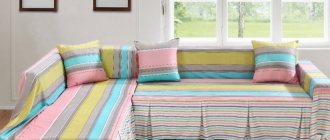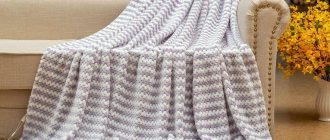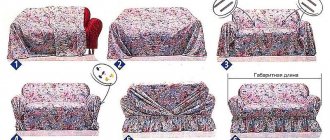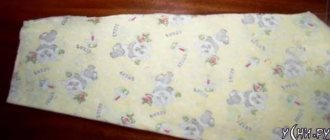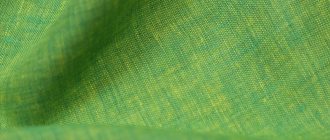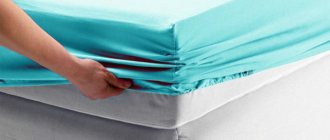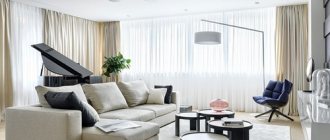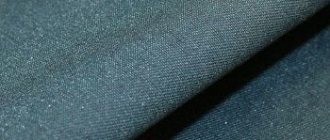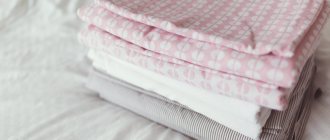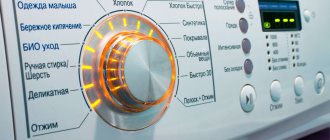Features of fabrics
Choosing the right fabric for a bedspread is quite difficult, especially given the wide variety of options. Each material has external features, performance characteristics, advantages and disadvantages that should be taken into account when choosing, because you want the bedspread to last for more than one month.
Classification of material depending on composition:
- natural - cotton, silk, bamboo, wool, natural fur and so on. Among the obvious advantages of such fabric for a bedspread are: environmental friendliness, pleasant feeling on the skin, good ventilation. The disadvantages are rapid wear, problems with washing, deformation, easy creasing, can cause allergies, high cost. Almost every natural fabric has a synthetic counterpart;
- synthetic materials - acrylic, microfiber, fleece, viscose, faux fur. Their advantages are elasticity, high strength, constancy of shape, wear resistance, preservation of bright color and attractive appearance, and low cost. Among the disadvantages are the inability to pass air and absorb moisture, and not always pleasant tactile sensations;
- mixed materials - a combination of natural and synthetic fibers together. This is an almost ideal option that combines the advantages of the main types.
But on sale we come across names of fabrics whose composition is not always familiar. They can be divided into several groups according to the main distinguishing feature - surface quality:
- smooth blended or cotton fabrics - percale, calico, satin, poplin;
- embossed fabrics made of wool, cotton or blends - jacquard, tapestry;
- fabrics with a printed pattern from a mixture, synthetics, silk - satin, brocade, silk;
- fabrics with a fleecy surface of any composition - fur, plush, velor, velvet.
- polyester synthetic fibers - velsoft, microfiber, fleece. This option is not very suitable for creating a stylish interior, since the material allows you to create fleece blankets that are quite thin and simple in appearance. It is used more often for children's beds.
Some of the most popular and favorite materials are:
- silk - you rarely see it in this quality, because it is expensive, and care seems quite troublesome. Nevertheless, a silk bedspread is the dream of many, as it has many advantages: high strength, excellent appearance over time, safety, a wide range of colors and patterns, and healing effects. The only disadvantage of the material is its high cost;
- Cotton bedspreads are the most common option. They are hypoallergenic, easy to care for, inexpensive, natural. The disadvantage remains the tendency to fade. Linen fabrics have similar properties;
- satin bedspreads can be made of silk or on an artificial or cotton base - the cost of the product will depend on this. The material is cheaper than silk, but is almost as beautiful as it. In addition, it has beneficial properties that allow it to be used for children and allergy sufferers. Problems can only arise with washing, so professional dry cleaning is recommended for the fabric;
- bamboo bedspreads became known to us not so long ago, but in vain - they are hygroscopic, soft, environmentally friendly, the fabric is dense and does not wrinkle. The only drawback is that the material is not suitable for rooms with high humidity;
- If the bedroom bedspread is made of tapestry, then it is almost impossible to find any flaws - it washes perfectly, retains its shape and color well, is a classic and fits almost any interior. Among the advantages, it is also worth noting environmental friendliness, varied design and a wide range. The only limitation in their use is that a tapestry bedspread does not look very appropriate in small rooms;
- a fluffy bedspread looks expensive and even luxurious, but will not last long. After a couple of washes or constant lying on them, a fluffy blanket quickly loses its presentable appearance and attractiveness, the pile “falls off”. A variation of this design can be called a plush version of the bedspread, or a product made of a material called “grass”;
- A fur blanket, whether made from natural or faux fur, looks very elegant and gives the room a unique coziness, but there are pitfalls. First of all, a fur blanket collects dust very strongly - this can cause allergies. It is almost impossible to wash it yourself - you will have to use dry cleaning services.
Such a rich composition of fabrics is an advantage of the modern weaving industry. By combining several types of fibers, it is possible to achieve the necessary characteristics, rich texture and varied density of the bedspread material.
Satin
Bamboo
From the tapestry
Fur
Cotton
Silk
Types and options of materials
For many years, the use of various fabrics for sewing covers for sofas, armchairs or beds has classified the fabrics according to the characteristics most in demand during the operation of the products.
Materials with the addition of cotton and synthetic fibers are popular. The model has an inexpensive budget. The combination of threads in different proportions gives stunning results in the production of modern linens for the manufacture of bedding and decorative products. The market dictates its tastes and priorities to production.
Cotton and silk fabrics, wool jacquard, tapestry of different densities, fleece and microfiber, bamboo and acrylic materials, all this is in demand by consumers who focus on their needs in the household.
Fabric options for bedspreads
It is difficult to choose a product based only on the color or texture of the fabric. Other factors are also taken into account when purchasing furniture covers:
- wear resistance of the product and durability of operation;
- elasticity and wrinkle resistance of the material;
- resistance to pollution;
- ease of care;
- color retention under the influence of ultraviolet radiation and repeated washing.
Adding synthetics to cotton raw materials will increase the wear resistance of the fabric, and an increase in natural components will reduce the elasticity and service life of the finished product.
Natural fabrics for furniture covers
Fleece
Material made from sheep's wool was introduced at the end of the last century. The inventors of the unique canvas were awarded the Nobel Prize. Synthetic plastic masses are the raw material for both the material and the production of plastic bottles. The long debate about the name of the covering fabric surprised many.
The main advantage of the fabric is its ability to retain heat even when wet. Lightweight and warm material has high strength and durability. High wear resistance and no pile rolling. You can quilt it. The fabric is suitable for people with sensitive skin and babies, so it is in demand as blankets, blankets and bedspreads. Does not wrinkle and does not require special care. Ideal as fabric for a blanket.
You might be interested in How to sew tulle on eyelet rings yourself
Interesting! Disadvantages include the accumulation of static electricity and dust. Do not iron with a hot iron.
Fleece blanket
Microfiber (velsoft)
The new ultra-thin fiber, which has high strength and absorbent properties, has been known to a wide range of consumers for no more than 30 years. Lightweight and soft material without falling out lint, practical to use and care.
Advantages of the fabric:
- high hygroscopicity;
- maintaining original softness and volume;
- absence of allergic reactions in the consumer;
- not susceptible to the spread of ticks and other insects.
Disadvantages include the accumulation of static electricity and the relatively high price of finished products. Can be used as bedspread fabric without using filler.
Soft microfiber for blanket
Wool jacquard
Making blankets and rugs from patterned fabric using a special machine has a complex technological process. Double-sided fabric is formed from the interweaving of camel and goat hair fibers and is considered one of the most expensive. In production it is possible to add fluff from Kashmir mountain goats.
A warm and light blanket has a healing effect on the human body, relieves fatigue and tension. It has high characteristics of strength, durability and appearance that does not deteriorate over time. Can be used as a fabric bedspread with processed fabric edges.
Important! Careful attitude and proper care of the product, which is not indifferent to moths, will extend its service life for a long time.
Jacquard bedspread
Cotton and bamboo
The use of cotton fibers in the production of many materials affects the price of the fabric and its characteristics. Calico products still delight with their colorful variety. Easy to care for, low density and excellent air exchange of the product.
Ease of cleaning and lack of allergies allow the products to be used in the production of bedding sets and bedspreads for small children. The product performs the simultaneous functions of a blanket and rug. High temperature during washing removes germs and dirt from the product. Types of cotton fabrics include calico, poplin, and satin.
Bamboo fabrics are spreading very quickly in the consumer market, leading in many respects.
- Antimicrobial properties of matter.
- The greenish tint of the fabric has a beneficial effect on the mental state.
- Ecological purity of bamboo fabric.
- Maintains its original appearance after numerous washes.
- High hygroscopicity and neutralization of sweat odors.
- Breathability.
Create a microclimate in hot or cold conditions using a blanket that does not attract dust. No shortcomings have been identified yet.
Cotton blanket
Silk
Silk fabrics are unsightly for the growth of mites and mold, so they are suitable for allergy sufferers. They do not have a harmful effect on the human body because they contain proteins and amino acids of natural origin.
You might be interested in: We sew a blanket from sheep, merino or yak wool yourself
Silk fabric has a positive effect on blood circulation, normalizing blood pressure. Products made from silk thread improve the functioning of the digestive tract and have a beneficial effect on the nervous system.
The attractive appearance and high price of products made from natural ingredients are not available to all consumers. Has high strength and durability. Some skill is required in care, especially in washing and ironing.
This material, amazing in beauty and quality, is made from silkworm cocoons weaving the finest silk thread. Varieties of fabrics containing silk fibers include satin with a shiny surface on one side.
Set with a bedspread of European standards
Viscose
Viscose fabrics are the first synthetic material. Cellulose, through processing into an organic substance, undergoes processes of transformation into thin threads under high pressure. Contains natural and artificial ingredients and remains safe for use in many applications.
The advantages include the following fabric qualities:
- saturated color;
- acceptable price;
- breathability;
- elasticity.
If improperly cared for and exposed to a hot iron, the fabric may deteriorate.
Viscose blanket
Wool
Wool blankets always have a beneficial effect on human health. Dry heat and a healing effect are provided by fibers from the down and wool of sheep and camels. Easy maintenance ensures long service life. Particular attention is required to protect the product from moths and dust mites. Beating, airing and treating the bedspread with hot steam can reduce allergic effects in people with hypersensitivity.
Camel wool blankets are not brightly colored. Most often these are shades from milky to dark brown, with artificial threads interwoven. Neutral colors have a positive effect on a person's emotional state.
Calm colors in the interior
Velvet
The advantages of a fabric that creates an intimate atmosphere with its lightness and softness are undeniable. Natural material has a high cost and is used in rooms reserved only for sleep and proper rest. The fabric does not have high wear resistance qualities and requires careful handling and care. In many qualities it is similar to velor.
Sofa set of bedspread and pillows
The material can be different, for example, to answer the most popular question: “fabric for a blanket, what is it called?” There may be different answers:
- Cotton;
- Jacquard (wool);
- Silk;
- Tapestry;
- Atlas;
- Viscose;
- Fleece;
- Microfiber.
Models and cuts
In contrast to the variety of colors and styles, bedspread models rarely present any new items. There are a small number of basic ones:
- rectangular is the most common bedspread model, looking like a large thick sheet on a bed. There are several types, for example, single-layer or double-layer. Their main difference will be the material and thickness. Single-layer ones are usually sewn from thick and dense fabrics, and two-layer ones are made from thinner and more natural ones;
- The double-sided model of the bedspread allows you to make no distinctions between sides - there is no reverse side. The material used can be the same or different - they differ in color and texture. In this case, it is recommended to sew the same double-sided covers on the pillows;
- cover - if the bed is made of expensive wood, decorated with carvings or other beautiful decor, or is a podium, then an unusual bedspread model is often chosen - in the form of a cover. In total there are 2 types of them. The first one looks like a cover and is sewn a maximum of 10 cm more than the height of the mattress. The second one has an elastic band, which allows you to tuck the edge under the mattress, as if it were completely inside the cover. The latter is great for podium beds, while the former is great for everyone else. It is necessary to choose such a model strictly according to its parameters;
- bedspread with valance - is an unusual model with a wide frill on 3 sides. This unusual product is usually chosen for high beds. The height allows the bedspread to show off perfectly and show imagination in design - for example, the top part can be made of silk, and the hanging part can be made of chiffon.
Of course, sometimes you need a bedspread for a round bed of non-standard dimensions - then individual tailoring is recommended, since it is almost impossible to find suitable industrial production options.
Bilateral
With valance Case
Rectangular
Possible sizes
How to choose a bedspread and not make the wrong size? Since most beds have standard dimensions, bedspreads are also suggested to be selected according to these standards:
- for children, bedspreads are available in the following sizes - 75/80; 100/120; 110/140;
- for a single bed – 140/200;
- for a double room – 170/210;
- euro – 200/220 and euro maxi – 220/240 or 240/260.
All sizes shown are in centimeters. For non-standard bed dimensions, it is recommended to sew a custom-made bedspread.
It’s quite difficult to imagine exactly what the purchased item will look like on the bed, so it’s better to do the calculations in advance. It will be necessary to determine several parameters of the existing bed - its length, height, width. Now we add 20 cm or more to the width - this is the most optimal option to cover the bed linen.
If you need to hide the mattress, then measure its height and add centimeters to the size for allowances. There are those who like to turn a sleeping place into a “pedestal”, which is covered with a king-sized blanket. In this case, the width is measured taking into account the allowance to the floor. It’s fashionable if the bedspread “drags” even a little on the floor - add another 10 cm.
The last option is not suitable for all bed models - if the frame protrudes from the mattress at a distance of more than 5 cm, then you should choose another option. A large protrusion will be visible under the blanket, which looks rather tacky. It is worth considering that most modern beds have a headboard, so there is no increase in centimeters on this side.
Patterns and prints
How to choose a bedspread depending on the pattern is no less important than the size and cut. Bedding is not influenced by fashion trends to the same extent as everything else. Their design is quite constant, apart from minor changes in color preferences and materials. There are several main directions in patterns that are relevant at the moment:
- knitted bedspread models have gained popularity not so long ago, but they are not going to lose ground for a very long time. This is not surprising - they bring a feeling of comfort and warmth to the room. If the blankets are plain, then be sure to have a large knit or a relief pattern. In the case of a multi-colored option, it is worth giving preference to motifs. First of all, handmade products are valued, and this should be immediately obvious from them - loops that are not quite straight and flaws in the pattern are welcome. The material you can choose from is pure wool, synthetics or cotton yarn;
- Patchwork bedspreads used to be considered the preserve of the poor, because fabric scraps were used to create the products. Nowadays, to create a patchwork-style bedspread, very expensive materials with a smooth or embossed surface are often used, which are assembled from individual patches in the form of a mosaic. They look very stylish, but are not suitable for all interior styles;
- Floral and plant motifs on bedding are still in demand, but their appearance is changing slightly along with new designs. Perhaps the only thing that remains unchanged is the bedspread in the Provence style. Light colors, floral patterns, natural fabrics - a cozy bedroom is ready;
- a white bedspread is one of the most stylish options that will look good in any interior;
- complex combinations of shades are in great demand, but suitable ones are selected for each style - these can be beautiful bright stripes, checks, flowers, and so on. The only exception in all this multicolor is that the snakeskin print is no longer relevant;
- Quilted bedspread models allow you to achieve several goals at once - to show the texture of the material, its pattern in the most favorable light, and to give additional volume to the product. In this way, you can process almost any blanket that consists of 3 layers: lining, filling, decorative material;
- Turkish bedspreads have long been loved due to their wide range, but the waffle model made of cotton is especially interesting. It has a very interesting texture in the form of a three-dimensional cell;
- frills and ruffles on bedding are especially suitable for interiors designed in a classic style. If previously these details were placed only along the edge of the bedspread, now it can be completely covered with them and look very stylish at the same time.
When choosing a suitable bedspread, you should definitely focus on the style of the room’s interior, otherwise harmony will not be achieved.
White
Knitted
Patchwork
With ruffles
Quilted
Floral
Bright
Types of materials
Manufacturers offer bedspreads from various fabrics to suit every color and taste. Good material should:
- have a dense structure to maintain shape;
- be resistant to burnout;
- maintain its appearance after repeated washings.
To make the bedspread happy, before choosing, you should familiarize yourself with the characteristics of the fabric.
Cotton
Natural composition is the main advantage of cotton. Such a bedspread fills the house with comfort and tranquility; it is pleasant to look at and makes you want to touch it. Advantages:
- budget cost and durability;
- breathability and moisture absorption;
- is not a dust collector and does not cause allergies;
- Thanks to the variety of designs, it matches any interior and becomes a bright accent in the design.
A minor drawback of the material is its simplicity compared to expensive fabrics, which is successfully compensated by practicality.
Bamboo
Bamboo bedspreads are gaining popularity. The properties of the canvas are identical to linen, but bamboo is softer. Advantages:
- antibacterial properties are preserved due to non-thermal treatment of the fibers;
- soft structure resembles natural silk. The fabric thread is thinner than human hair, so the products are soft to the touch;
- does not fade or lose shape when washed (temperature should not be higher than 30-40 degrees);
- hypoallergenic.
A bamboo blanket has good thermal insulation qualities. It is comfortable both in winter and in summer.
Silk
The material is associated with luxury, wealth and perfection. The touch on the body is as light as a feather. A silk bedspread has undeniable advantages:
- pleasant tactile sensations;
- has a positive effect on the skin, improving blood circulation;
- resistance to fire - when a spark hits, the material does not flare up sharply, but smolders;
- hygroscopic (absorbs moisture well) and breathable (allows the body to breathe).
A small fly in the ointment: high price, difficult to care for and difficult to iron.
Atlas
The fabric is created from artificial or natural fibers. The shine is provided by the peculiarity of the weave of the threads. Pros of a satin bedspread:
- tactile sensation of coolness in hot summer;
- appearance;
- durability, wear resistance.
Requires careful handling and has a high price. The synthetic analogue will be several times cheaper.
If there is a cat living in the house that will take a liking to a bed covered with a bedspread, you should abandon smooth fabrics with a delicate structure in favor of cotton or synthetic bedspreads. On silk or satin, damage will appear from a light touch with claws.
Viscose
An artificial material created by man based on cellulose. It is considered a middle link between natural raw materials and artificial ones. Advantages of viscose bedspreads:
- does not lose color saturation for a long time;
- low price;
- breathability.
But it wrinkles and needs delicate care.
Acrylic
The structure of acrylic yarn has something in common with wool. It is created from acrylonitrile, obtained from natural gas through chemical reactions. The advantages of bedspreads made from this fabric:
- light weight, you can even take it with you on a trip;
- long service life;
- does not fade or deform;
- does not cause allergies.
The only drawback is that it accumulates static electricity.
Acrylic fabrics appeared after the end of World War II. The discovery was not widely used due to its unattractive appearance. Chemists were unable to achieve permanent coloring of the canvas. Several years passed until the synthetic material acquired a brightness that was not lost after repeated washing.
Tapestry
Tapestry bedspreads complemented the interior back in the Middle Ages. In small bedrooms, a tapestry is not appropriate, as it reduces the space. Linen (a mixture of cotton and synthetics) - the embodiment of wealth and status - will take root in spacious rooms. Its advantages:
- increased strength;
- environmental friendliness;
- high rate of creasing, does not stretch;
- color stability, attractive ornaments, abundance of textures, ease of maintenance.
A tapestry bedspread is expensive and requires detailed selection of style.
Jacquard
The bed, elegantly covered with a jacquard bedspread with large patterns and shimmers in the sun, looks elegant in the bedroom. The composition may include: linen, satin, silk, wool, cotton, spandex and elastane. Advantages:
- variety of colors;
- appearance;
- durability of matter;
- moisture resistance;
- not electrified.
Minor disadvantages of textiles: washing is carried out in a delicate mode, price. If the bedspread contains wool, it may not be suitable for people prone to allergic reactions.
Fleece
Synthetic fleece material is soft and fluffy. This blanket retains warmth like real wool, even when wet. Advantages:
- washes well and dries quickly;
- has heat-protective properties;
- durable, wear-resistant, breathable material;
- does not retain moisture;
- does not roll down.
Disadvantages: electrification and rapid accumulation of dust.
Microfiber (velsoft)
Real microfiber is made of 100% polyester, its fibers are finer than silk. Among the advantages of microfiber bedspreads:
- breathability and moisture evaporation;
- does not require ironing and is easy to clean;
- does not deform and retains brightness after washing;
- has a fluffy surface that is pleasant to touch;
- is hygroscopic;
- Gives a feeling of freshness on a hot summer night.
Do not dry on batteries, heat treatment will lead to deformation. If you properly care for a microfiber bedspread, it will last longer than products made from other fabrics.
Wool
A bed or sofa with a wool blanket thrown over it adds coziness to the room. The fibers are made from the wool of rams, sheep, llamas or Angora goats. Advantages:
- ease of care due to the ability of wool to self-clean;
- service life;
- quick drying.
Disadvantages of bedspreads: allergenicity, “hits” the wallet of the average consumer, and a small selection of colors for products made from camel wool. But the last drawback is conditional, because neutral colors have a positive effect on a person’s emotional background.
Velvet
Velvet voice, velvet skin - the definition of a special thoroughbred, characteristic of nobles and nobility. Velvet bedspreads are associated with tenderness and sophistication. They are fluffy, soft and pleasant to the touch, for romantic natures.
At the same time: high price, minimal resistance to abrasion with the formation of bald spots and difficult to clean from animal hair, if there is any in the house.
Colors and combination rules
The bedspread should be a certain color because it will create or complement a certain mood in the bedroom. When choosing the appropriate range, several factors should be taken into account:
- It is recommended to use soothing shades in the bedroom, if this does not contradict the overall style of the interior;
- on which side is the room located - if it is the north side, where there is almost no sun, then it is advisable to give preference to warm tones, if it is to the south, then cold ones;
- bedroom size: if it is spacious, then you can make a bright accent using a purple or red bedspread; if it is small, choose light shades that will visually expand it;
- style and range of interior.
Most often, to get a good result when choosing the color of a bedspread, it is recommended to use one of three schemes:
- to match the walls - this does not mean that blue walls necessarily need a blue bedspread - blue, dark blue, that is, different in several shades, will do;
- to match the interior palette - from all the interior colors, the dominant one is selected, which the fabric of the bedspread must match;
- to match the curtains - this technique is usually used, but you should not sew these products from the same fabric - this is an outdated technique. They should at least be of different shades, or have a different pattern.
Of course, the choice of color depends entirely on the taste of the owners of the room, their preferences, but now it is worth paying special attention to “natural” shades - they are on trend. This is the natural palette that surrounds us - mushroom, earthy, rich pure colors: eggplant, dark blue, black.
Gray bedspreads are especially popular - from “wet asphalt” to a light shade, similar to a shade bleached with time. A plain bedspread in this range, with filling and stitching, looks especially advantageous.
Modern bedspreads come in a wide range of models and colors, but this only works to our advantage, because you can choose the best option for your bedroom.
History of textile decoration
The campaigns of the Crusaders ultimately led to the fact that trade began to develop briskly and a stream of hitherto unknown luxurious fabrics poured in from the east.
The interior, richly decorated with expensive silks, brocades, velvets, appliques and embroidery, became very popular. Fabric decor was not just a symbol of luxury, but also a distinctive feature of the interior.
The motifs of this design are still present in decorative bedspreads: shimmering natural silk, soft velvet, embroidered fabrics.
Time passed, the luxurious apartments were replaced by the same type of small-sized apartments, in which such decor looked ridiculous.
In times of total shortage, it was very difficult and expensive to buy anything, so needlewomen crocheted beautiful bedspreads for the bedroom or sewed them from pieces of fabric using the patchwork technique.
Today, a bedspread for a bedroom can be easily purchased at any online store that sells new textiles.
